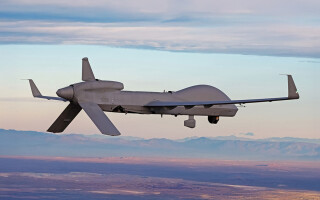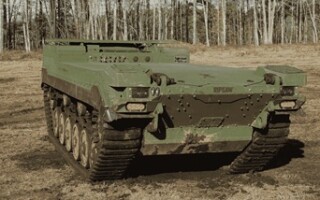GUEST BLOG: Smarter by design – How AI Is rewriting the rules of defense engineering
BlogJune 11, 2025

Today’s defense and intelligence missions face a persistent challenge in that high-fidelity optics and sensor systems are expensive and slow to produce. The sector remains stuck in the size, weight, power, and cost (SWaP-C) dilemma, where engineering tradeoffs restrict performance, delay innovation, and increase costs. However, artificial intelligence (AI) can now be harnessed to model millions of design iterations in seconds, allowing for advances in materials such as metasurfaces and metalenses to be incorporated into exquisite optic and system systems helping to overcome traditional SWaP-C limitations.
Defense and intelligence operations increasingly depend on fast, precise, and distributed sensing. From satellites and unmanned aerial systems (UASs) to maritime intelligence, surveillance, and reconnaissance (ISR) systems and autonomous ground platforms, optical and sensor technologies are essential for national security. Yet for decades, these systems have been governed by a familiar engineering balance: the size, weight, power, and cost (SWaP-C) dilemma.
Historically, advancements in one of these dimensions came at the expense of others. A sensor that delivers high-resolution imaging might be too heavy or expensive to use on a small drone. A lightweight lens may lack spectral range or thermal resilience. A lower-cost system might forgo adaptability or accuracy. This tradeoff has shaped procurement cycles, constrained platform design, limited mission scope, and slowed the pace of innovation.
That dynamic is starting to shift. When artificial intelligence (AI) is deeply integrated into the engineering process, it can unlock new possibilities for optics and materials design. For the defense community, this new reality marks a fundamental change in how systems are imagined and built.
AI’s role in redefining optical system design
Optics are a core enabling technology across defense use cases, yet they remain slow and costly to design. Metalenses – flat, nanostructured surfaces that manipulate light at subwavelength scales – are a compelling alternative to traditional glass-based systems. Their form factor is thinner, lighter, mass-produceable, and easier to integrate into small and unconventional platforms.
However, their design complexity has always been a research and development challenge. Designing a metalens to function across a target wavelength range, polarization state, or field of view requires tuning an immense number of interrelated variables. This process used to require months of manual design iterations by experts, combined with extensive simulation and prototyping.
AI upends this process. Now, scientists and engineers can evaluate millions of design permutations in parallel. AI-based optimization tools can prototype lens designs that meet multiple mission criteria simultaneously by solving the inverse design problem, without the need for costly or time-consuming guesswork. These tools can account for environmental parameters, manufacturing constraints, and system-level requirements from the outset, producing validated designs that are technically robust and operationally viable.
AI-designed metalenses have already demonstrated strong potential across optical spectrums, from visible light to infrared and radio frequencies. They offer a way to create scalable, mission-tailored optics that can be quickly developed for use cases from attritable aerial ISR to spaceborne sensors and beyond.
From sensors to systems
Harnessing AI for optics innovation is also enabling new kinds of systems. When sensors can be made smaller, lighter, cheaper, and more quickly, entire architectures can change.
For instance, low-cost, AI-optimized optics make it feasible to field swarms of collaborative ISR assets with overlapping, redundant vision. This can create resilience through scale rather than individual system hardening for exquisite platforms. In space, compact lenses reduce payload mass and launch costs, opening the door to constellations with diversified sensing capabilities. In maritime and underwater environments, sensors that can adapt to multi-spectral requirements without physical reconfiguration expand the reach of autonomous platforms.
These new configurations were impractical with traditional optical engineering. They are only becoming feasible because AI-powered design tools can now outpace human creativity and conventional prototyping cycles.
Importantly, these tools are not limited to optics or to a single part of the electromagnetic spectrum. The same methods are increasingly being used in advanced materials development, which is another area where performance constraints have dictated what’s deployable.
Meeting the demands of hypersonics
Consider the problem of design for hypersonic flight: Operating at speeds above Mach 5 exposes vehicles to extreme thermal and structural stress. The aerospace community has spent years experimenting with high-temperature composites and coatings, often relying on incremental improvements to legacy materials.
Researchers can now use AI to simulate and evaluate new materials with unprecedented speed and fidelity. These methods accelerate the discovery of formulations that dissipate heat more effectively, resist oxidation, and remain structurally stable under high strain rates. This leads to faster progress and the ability to optimize material performance for mission-specific flight requirements. This pushes the limits of survivability and maneuverability at extreme speeds.
As with optics, AI enables engineers to start from the problem and work backward toward novel solutions. That reverses a long-standing paradigm in defense acquisition, where systems are often shaped by what the available components can support.
The end of the tradeoff era
For too long, the defense community has accepted engineering tradeoffs as unavoidable. AI helps the industry move beyond the traditional SWaP-C tradeoffs. With AI-driven tools, teams can design advanced optics, materials, and autonomous systems that are smaller, faster to produce, and more capable at the same time. What once required months or years of manual iteration can now be accomplished in days, hours, minutes, or seconds, with greater precision and flexibility.
This shift marks a fundamental change in how national security technologies are conceived and delivered. AI is no longer just a support tool; it is becoming the foundation for a new model of defense innovation. To take full advantage of this progress, defense organizations need to rethink how they develop, test, and field new technology. AI offers a path to faster, smarter, and more flexible defense capabilities.
Core4ce · https://www.core4ce.com/






